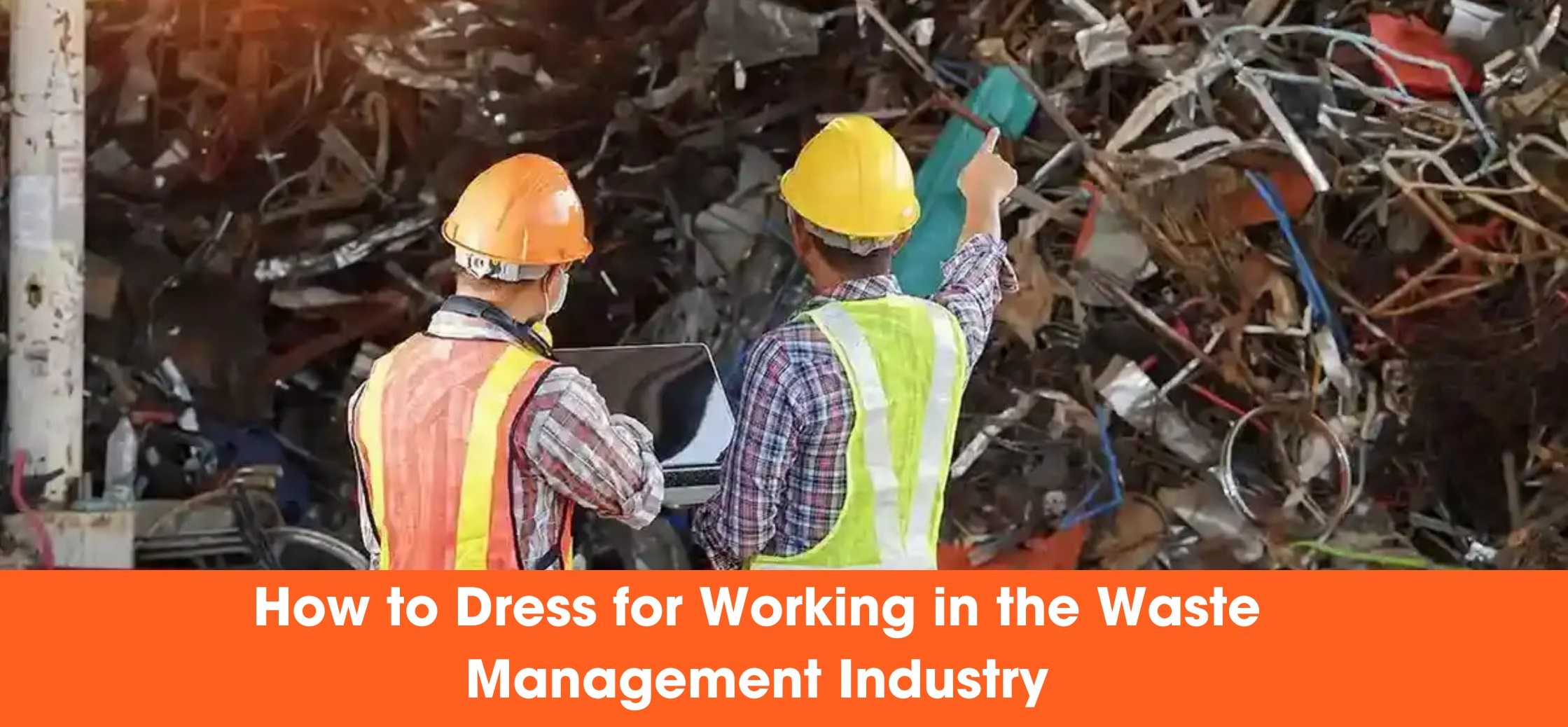How to Dress for Working in the Waste Management Industry
20th Apr 2024
For those who work in the waste management industry, heavy machinery, road dangers, and hot and cold weather are all part of the daily grind. Therefore, in order to ensure that they can perform their duties in a safe and efficient manner, waste management workers need professional-grade protection when they are out there gathering, transporting, and processing the world's rubbish and recycling. Which are the essential items of safety gear for trash management? Now is the moment to learn! We will discuss the essential personal protection equipment (PPE) that all sanitation workers need to carry in this section. Let us first examine the types of risks that waste management specialists encounter in their line of work.

Typical Risks Associated with Waste Management
Any garbage collection or processing company should place a high premium on minimising worker injuries caused by waste handling. To do that, it's necessary to comprehend the main risks faced by waste management professionals, such as garbage collectors and employees at recycling facilities. Here are a few of the most important risks to be mindful of:
- Vehicle Hazards: Municipal garbage collection service employees are frequently in close proximity to moving cars. Garbage workers moving on the street can be difficult to see for those driving by in other cars or even for the person operating the garbage truck. Meanwhile, workers in recycling centres and other garbage processing facilities have to watch out for vehicles like forklifts.
- Machinery Risks: The hefty lifting and crushing mechanisms on garbage trucks make it easy for employees to cut their hands, feet, or other body parts. In the meanwhile, if safety precautions aren't taken, personnel operating sorting and processing machines in waste processing facilities run the risk of suffering serious injuries.
- Weather hazards: Sanitation workers in the field may be at risk from a variety of weather conditions, including intense heat, freezing rain, and snowfall. Frostbite, sunburn, and overheating can all occur when improper weather protection is not used. Cut and Puncture threats: Every day, workers in the waste management business face cut and puncture threats from sharp materials such splintered wood, broken glass, and jagged metal.
- Ergonomic Hazards: Lifting heavy things, such as garbage cans, repeatedly is a common task in waste management. If workers are not wearing the proper ergonomic gear, they run the risk of putting pressure on their backs, knees, ankles, or other joints.
- Eye hazards: When waste materials are disposed of, crushed, and processed, small pieces of flying debris may be released, endangering the eyes of nearby workers.
Clearly, these risks are serious business. What then is the key to ensuring the safety of waste management employees?
What to Look for in Workwear for Waste Management
When it comes to waste management safety, personal protective equipment (PPE) is a crucial component of the equation. When purchasing protective gear, waste management experts consider the following factors:
- High Visibility: Work clothing with reflective tape and neon colours are essential for waste collection professionals. Operators of machinery and vehicles can see workers more easily thanks to these visibility characteristics. Workers may occasionally be required to wear hi-vis clothing with an ANSI 107 rating, which is the national professional standard for hi-vis apparel and calls for a specific quantity of reflective and bright material.
- Weather Protection: It's critical to wear clothing appropriate for the weather for garbage collection employees who are exposed to various weather conditions while on the job. This could entail wearing a light work shirt in the summer, a waterproof jacket in the rain, or a well-insulated coat on a chilly day. Long sleeves with a UPF value can be essential for avoiding sunburn in sunny weather.
- Breathability and Comfort: Sanitation workers require comfortable, breathable gear regardless of the weather. Good ventilation is sometimes achieved by the use of mesh textiles in clothing, such as safety vests. Today, almost all types of workwear, including gloves, trousers and jackets, have ventilation elements to assist keep the wearer cool. Another important component of clothing that actively moves perspiration away from the wearer's skin to avoid chafing and maintain a healthy body temperature is moisture wicking. Ergonomics and Flexibility: If an employee's work equipment restricts their range of motion, they will find it more difficult to perform the proper ergonomic movements while on the job. For this reason, the ideal work clothes for waste management professionals should feature integrated flex points in places like the back, knees, and crotch to ensure that employees may bend and stretch as much as necessary.
Essential Safety Clothes for Waste Management
What kind of clothing is appropriate for waste management workers to wear at work? There are basic necessities that most workers will need at some point, however the exact answer will always depend on the environment, the nature of the labour, and other considerations. For waste collectors, employees at landfills and recycling facilities, or anybody else involved in waste management, these seven items of equipment are essential.
1. A vest with high visibility
One of the most popular PPE equipment for waste management professionals is a high-visibility safety vest. Hi-vis vests are a practical and cost-effective solution to increase sanitation workers' visibility and keep them safe while working. They also come in a variety of features to meet a variety of demands and are comfortable and simple to put on and take off.
An ANSI Class 2 or Class 3 vest may be necessary, depending on where and when the worker will be doing their duties. Are ANSI-rated vests unnecessary? Look through our selection of reasonably priced non-ANSI enhanced visibility vests. We provide a large number of colours so you may easily color-code worker vests according to position, training, contractor status, or almost any other characteristic. Because breakaway vests are made to break off when pulled, they can also be an excellent option for garbage management since they help keep employees safe from getting entangled in moving machinery. Lastly, have a look at our assortment of surveyor vests with lots of pockets if you're a worker in need of a handy carrying spot for small tools and materials.
2. Headgear
Another essential element for ensuring the safety of garbage disposal personnel in all weather conditions is hi-vis headgear. A knit beanie—with or without a fleece lining—is a common option for protecting a worker's head and ears from frostbite in cold weather. A full-face balaclava may be the best option in extremely cold weather to protect delicate parts like the nose. A baseball cap or safari hat can be quite helpful in keeping the sun off the face and neck, even in sunny weather. In order to protect their eyes from flying debris, workers in waste management facilities frequently need safety eyewear. Lastly, keep in mind that a lot of work hats now come with improved visibility features that can make it easier for employees to be seen.
3. Workplace Tee
Since hi vis work shirts may provide ANSI Class 2 or Class 3 visibility protection without compromising a light and breezy feel, they are a go-to choice for workwear when visibility is required in warmer situations. Work shirts that are well-made are created to be exceptionally comfy after a long day of labour, whether the wearer is sorting recyclable glass or collecting trash cans. The wide variety of styles and materials that hi-vis work shirts come in contributes to their popularity. A vast array of cosy work shirts, in both short- and long-sleeve styles, is available from HiVis Supply. To meet your dress code or desired style, pick from a variety of t-shirts, polo shirts, button-up shirts, and more. We offer numerous breathable fabric alternatives, such as moisture-wicking birds-eye polyester shirts.
4. Gloves
Managing waste necessitates moving large objects and using machines, frequently in inclement weather. Another serious worry is the possibility of cuts from sharp items. This implies that in order to prevent cuts and abrasions on their hands and maintain a firm hold on whatever they're handling, sanitation workers must always wear durable gloves. Rubberized palm grips, reinforced knuckle armour to protect from impacts, and neon safety colours for increased visibility are important qualities to look for in gloves for garbage management. Waterproofing and insulation are also crucial components if employees will be working outside in cold or damp weather. Last but not least, ANSI cut-rated gloves are necessary for tasks where there is a high risk of cuts. However, before purchasing any gloves, be sure the ANSI cut rating matches your requirements.
5. Rain Gear
For waste management professionals working in the field, hi-vis safety rainwear is an additional necessary piece of equipment because garbage and recycling collectors are not allowed to take a day off due to bad weather. To choose the appropriate rain gear, start by learning the differential between clothing that is water resistant and waterproof. It's crucial to keep a variety of temperature degrees of rain clothing on hand. For the winter months (see below), a lightweight rain jacket is ideal when the weather is rainy but milder, and a waterproof parka is a need. Additionally, HiVis Supply sells complete rain gear kits with zip-out linings that allow users to tailor the clothing to their ideal degree of warmth. Remember that rain makes it extra harder for workers to be seen on the road, so think about whether you'll require ANSI-rated rain gear. Check out our list of the top picks from our hi-vis rainwear range and get more advice on how to choose wisely by reading about the five key considerations!
6. Winter/Fall Jacket
Sanitation personnel in the field will need warm, durable clothes for the colder months of the year, unless your waste management organisation is located somewhere where it never gets cold. A lightweight quilted jacket or hi-vis sweater for the fall and/or spring is a fantastic place to start, but when winter sets in, it's critical that workers have something thicker and more durable. While traditional parkas offer robust protection, some of them don't allow sanitation workers the necessary degree of mobility. For waste management personnel on the go, bomber and softshell jackets are two terrific styles that can provide considerable warmth without sacrificing flexibility.
7. Trousers
Wearing bib dungarees or hi-vis pants with a hi-vis outfit offers waste management professionals numerous advantages. First of all, it's a fantastic technique to increase visibility even more. In fact, you can create an ANSI Class 3 ensemble by wearing an ANSI Class 2 shirt or vest with a pair of ANSI Class E trousers! Another essential item for keeping waste management workers dry during inclement weather is a pair of waterproof hi-vis trousers. Some waste management professionals who work in tough environments also wear waterproof bib dungarees as part of their hi-vis attire for added warmth and water resistance.
It's time to equip your entire trash management team with the best high-visibility personal protective equipment! The workwear assortment at HiVis Supply offers competitive pricing on everything waste management professionals need to operate safely and successfully in their positions. View all of our waste management safety apparel alternatives or browse our selection of hi-vis clothes to learn about all of your possibilities!

 British Pounds
British Pounds
 United Arab Emirates Dirham
United Arab Emirates Dirham
 Canadian Dollar
Canadian Dollar
 Euro
Euro
 US Dollar
US Dollar
 FREE UK DELIVERY ON ALL ORDERS OVER £75
FREE UK DELIVERY ON ALL ORDERS OVER £75




